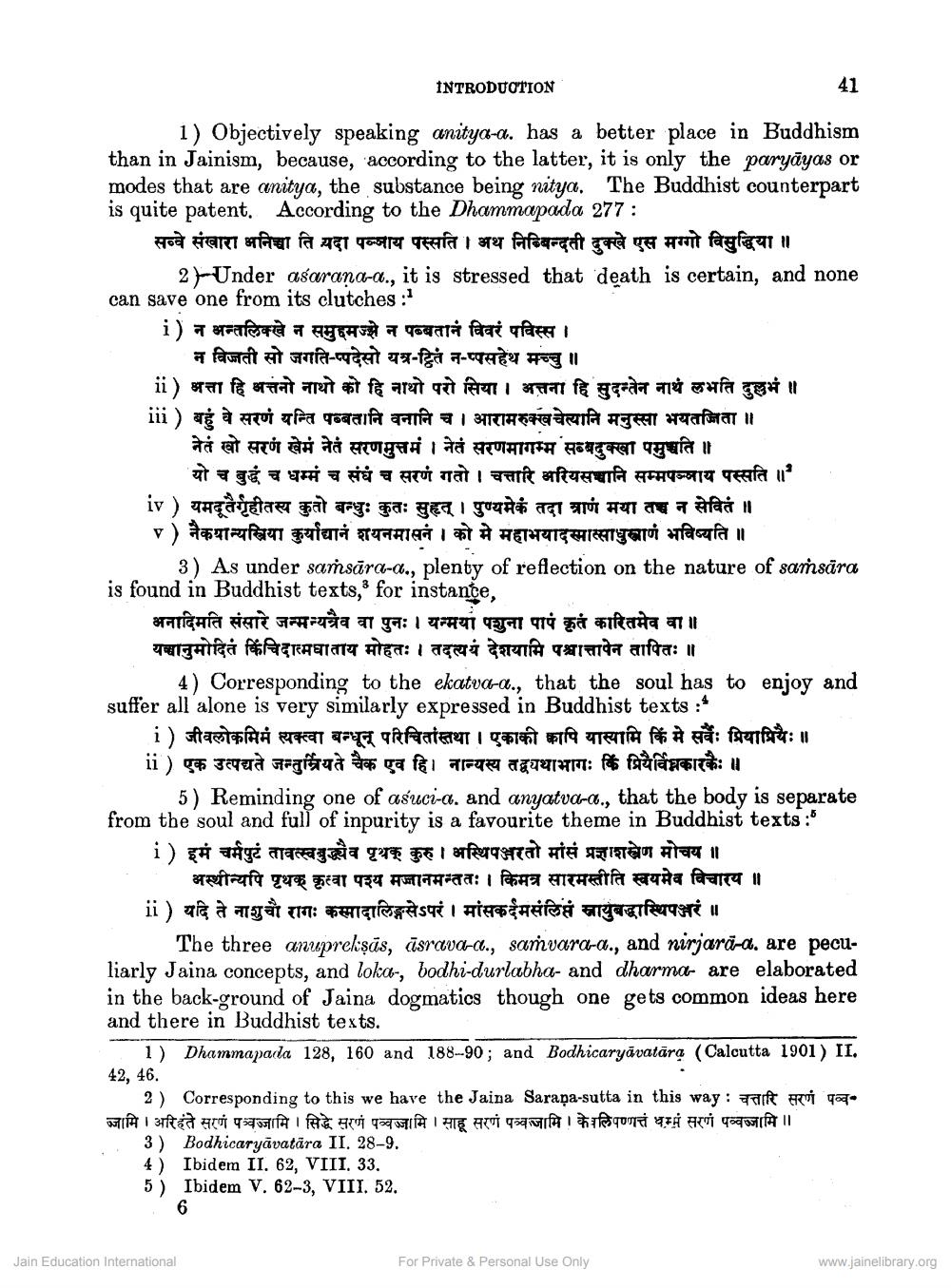________________
INTRODUCTION
41
1) Objectively speaking anitya-a. has a better place in Buddhism an in Jainism, because, according to the latter, it is only the paryāyas or modes that are anitya, the substance being nitya. The Buddhist counterpart is quite patent. According to the Dhammapada 277 :
सब्वे संखारा अनिचा ति यदा पन्जाय पस्सति । अथ निम्विन्दती दुक्खे एस मग्गो विसुद्धिया ॥
2 Under asarana-a., it is stressed that death is certain, and none can save one from its clutches :
i) न अन्तलिक्खे न समुहमज्झे न पब्बतानं विवरं पविस्स ।
न विजती सो जगति-प्पदेसो यत्र-ट्टितं न-प्पसहेथ मच्चु ॥ ii) अत्ता हि अत्तनो नाथो को हि नाथो परो सिया। अत्तना हि सदन्तेन नाथं लभति दल्लभं । iii) बहुं वे सरणं यन्ति पब्बतानि वनानि च । आरामरुक्खचेत्यानि मनुस्सा भयतजिता ॥
नेतं खो सरणं खेम नेतं सरणमुत्तमं । नेतं सरणमागम्म सम्बदुक्खा पमुञ्चति ॥
यो च बुद्धं च धम्मं च संघं च सरणं गतो । चत्तारि अरियसञ्चानि सम्मपञ्चाय पस्सति ॥ iv) यमदूतैर्गृहीतस्य कुतो बन्धुः कुतः सुहृत् । पुण्यमेकं तदा त्राणं मया तश्च न सेवितं ॥ v) नैकयान्यस्त्रिया कुर्याद्यानं शयनमासनं । को मे महाभयादस्मास्साधुस्खाणं भविष्यति ॥
3) As under samsāra-ca., plenty of reflection on the nature of samsāra is found in Buddhist texts, for instante,
अनादिमति संसारे जन्मन्यत्रैव वा पुनः । यन्मयां पशुना पापं कृतं कारितमेव वा॥ यच्चानुमोदितं किंचिदात्मघाताय मोहतः । तदत्ययं देशयामि पश्चात्तापेन तापितः ॥
4) Corresponding to the ekatva-a., that the soul has to enjoy and suffer all alone is very similarly expressed in Buddhist texts :*
i) जीवलोकमिमं त्यक्त्वा बन्धून परिचितांस्तथा । एकाकी कापि यास्यामि किं मे सर्वैः प्रियाप्रियः॥ ___ii) एक उत्पद्यते जन्तुम्रियते चैक एव हि। नान्यस्य तद्वयथाभागः किं प्रियैर्विघ्नकारकैः ॥
5) Reminding one of asuci-a, and anyatva-a., that the body is separate from the soul and full of inpurity is a favourite theme in Buddhist texts :
i) इमं चर्मपुटं तावत्स्वबुद्ध्यैव पृथक् कुरु । अस्थिपञ्जरतो मांसं प्रज्ञाशस्त्रेण मोचय ॥ - अस्थीन्यपि पृथक् कृत्वा पश्य मज्जानमन्ततः । किमत्र सारमस्तीति स्वयमेव विचारय । ii) यदि ते नाशुचौ रागः कस्मादालिङ्गसेऽपरं । मांसकर्दमसंलिप्तं स्नायुबद्धास्थिपञ्जरं ॥
The three anuprekşās, cīsrava-d., samvara-a., and nirjarõ-d. are peculiarly Jaina concepts, and loka-, bodhi-durlabha- and dharma- are elaborated in the back-ground of Jaina dogmatics though one gets common ideas here and there in Buddhist texts.
1) Dhammapada 128, 160 and 188-90; and Bodhicaryāvatāra (Calcutta 1901) II. 42,46.
2) Corresponding to this we have the Jaina Sarapa-sutta in this way : चत्तारि सरणं पब्ब. ज्जामि । अरिहंते सरणं पञ्चज्जामि । सिद्धे सरणं पञ्चज्जामि । साहू सरणं पञ्चजामि । केलिपण्णत्तं धम्म सरणं पव्वज्जामि ।।
3) Bodhicaryavatāra II. 28-9. 4) Ibidem II. 62, VIII. 33. 5) Ibidem V.62-3, VIII.52.
Jain Education International
For Private & Personal Use Only
www.jainelibrary.org




